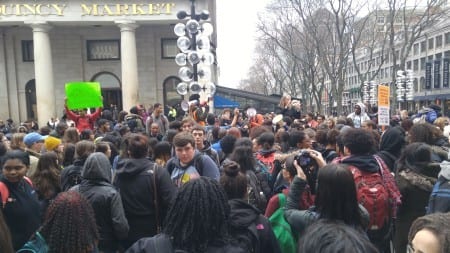
Image via High School Quiz Show / YouTube
March 29, 2106
BY JASON PRAMAS @JASONPRAMAS
Structural racism is the problem … now what’s the solution?
WGBH’s “High School Quiz Show” is great. So great that adults like me watch it on purpose regularly. And that’s why I’ve noticed something problematic about the show over the past few years.
There are very few Black (or Latino) contestants. Which is really weird. Because there are lots of Black students in Boston. And in a number of other Massachusetts cities as well.
Take a look at High School Quiz Show’s Facebook photos, and Instagram page, and YouTube page. Look for Black students over the seasons that WGBH has documented. Those who you see mainly appear during the program’s annual Super Sunday—where teams from 120 high schools try out for the next season. But the teams with Black students on them generally don’t make the cut for the show.
Why? Structural racism. And how does structural racism determine who shows up on “High School Quiz Show” every year? Because structural racism leads to educational inequality. Let’s take a look in broad strokes.
People with access to good jobs, housing, schools, and social supports have similar outcomes intellectually. But Black families nationwide, and Boston is absolutely no exception to this, continue to struggle more than their white counterparts economically and politically.
Without rehearsing the entire history of racism in America, Black families since World War I did not benefit from the major federal social programs that enabled huge numbers of white families to move up from the working class to the middle class … and beyond. Especially Federal Housing Authority loans that were targeted to new suburban developments that were kept lily white by use of racially restrictive covenants—which said that properties could only be sold to white people. Keeping Black families out of most white neighborhoods, towns and cities into the 1960s.
Suburban towns also passed zoning that stopped the building of multi-family dwellings—that is, apartment buildings—and tried to minimize housing construction of any kind in the richest towns. Making them accessible only to those who could afford to live there, even as major victories by the Civil Rights Movement finally made it possible for Black workers to move into better jobs across all economic sectors and for more Black families to start to move into the middle class.
Today, mainly white suburban realtors, lenders and insurers continue to discriminate against Black renters and homebuyers. With the result that quite a few towns and cities outside of Boston remain almost entirely white. And quite wealthy.
With many large expensive homes, these wealthy—and some middle class—suburban towns also have an impressively robust property tax base from which to fund excellent public schools. And wealthy parents kick in extra money to provide world class facilities for those schools—amenities that are completely absent from urban public schools. Plus they are able to send their kids to special after-school training programs and summer camps. Giving their children opportunities to excel academically that most urban kids simply do not have.
Add to those points the fact that since the 1960s, top students from East Asia and South Asia have been attending Boston universities in significant numbers, finding jobs in the professions here, and making enough money to move to the suburbs opened up to people of color with money by the Civil Rights Movement. Which remain off-limits to the vast majority of Black families that have been kept in redlined urban neighborhoods (even after suburbanites killed rent control), sold subprime mortgages on terrible terms for the houses they can buy there, and are still facing vicious discrimination in the job market. Ensuring they don’t make decent money or build capital as white families have been able to do for decades. And keeping them out of expensive white suburbs.
Forty years later, that’s how you get your typical “High School Quiz Show” team. From elite public and private suburban high schools in towns like Sudbury, Wellesley, Sharon, and Andover. Made up almost entirely of white and Asian students.
Regarding potential remedies for this particular manifestation of structural racism, there aren’t any easy ones. One suggestion, though. The “High School Quiz Show” FAQ currently says: “It is strongly recommended that teams include both male and female students.” Maybe amend that to conclude: “… and be as racially diverse as possible”? That would be a good start.
Apparent Horizon is syndicated by the Boston Institute for Nonprofit Journalism. Jason Pramas is BINJ’s network director.
Copyright 2016 Jason Pramas. Licensed for use by the Boston Institute for Nonprofit Journalism and media outlets in its network.



